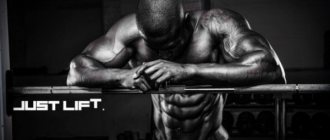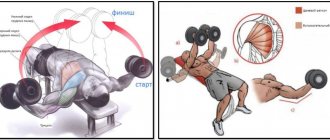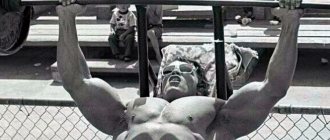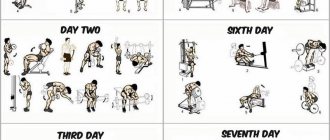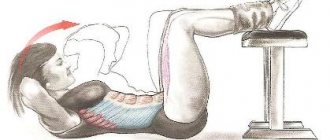Performance
Place the barbell on your shoulders and, holding it with a grip equal in width to your snatch grip, lower yourself into a deep squat position. From this position, press the barbell overhead. Be sure to straighten your elbows and squeeze your shoulder blades together. Ideally, you should hold this position for a split second before lowering the barbell back behind your head. Lowering the barbell smoothly and carefully, with full control of the movement, do not let it fall on your neck.
Before pressing the barbell overhead again, make sure it touches your trapezius. You don't have to pause at the bottom with the barbell resting on your shoulders, but there should be contact. Your squat position should exactly correspond to that of a classic barbell snatch, with appropriate, correct balance and feet pressed to the floor. The torso should remain motionless throughout the exercise and should be in the same position that you want to maintain when performing the barbell snatch (in the receiving position).
Bench press technique
The bench press is a classic core exercise for building the pectoral muscles, but since the bench press is a competitive movement in powerlifting, athletes and their coaches have refined the movement to allow athletes to lift more weight with less chance of injury, called the power press. If you have not yet studied the classic bench press technique, then you should start with it, but if you are already familiar with it, then you can proceed to the power press, but if your technical skill is already at a high level, you should pay attention to the following nuances. Firstly, distortions are very common, when on one side the barbell is lower than on the other, which is due to an incorrect grip and uneven position of the shoulders, or unequal innervation of muscle fibers. If you have problems with the grip or moving your shoulders back in the starting position, then you need to develop technical mastery in the bench press at a theoretical level. Problems with muscle innervation are somewhat more difficult to solve.
As a rule, the incorrect position of the barbell during the bench press is due to uneven muscle development, which is often offset by exercises performed with one lagging hand, which is fundamentally wrong. You need to correct muscle development with the bench press, in which case you have to make adjustments to the intensity of the training plan, reducing the weight on the bar to a level at which the athlete does not experience difficulties with evenly distributing the load between the muscles. Then the standard strength cycle of the bench press program is used, with a gradual increase in weight; if, with the next increase in the weight of the projectile, imbalance occurs again, then the weight needs to be reduced and trained for some time with this weight, gradually trying to increase it. In this way, you should train until the distortion in the bench press disappears completely.
Secondly, to improve the technique of performing the bench press, experienced athletes can use the “counter movement” technique. Let’s make a reservation right away that the technique is not suitable for everyone; athletes with a very flexible bridge, as well as those athletes who rest on the floor not with their heels, but with their toes, will not be able to use it. The essence of the technique is that the athlete takes the most rigid bridge in the lower phase of the amplitude of movement, and then, when he presses the barbell up, the legs relax, and the back and chest go down, moving away from the barbell, which gives additional inertia to the projectile. That is, after you take the barbell in the starting position, lowering it down, you bend even more, firmly resting your feet on the floor, when you rip the barbell off your chest, there is no longer any need to bend, so you can relax your legs and lower your chest down, moving away from the bar downwards. You need to develop the technique with a small weight, after which it can be gradually brought to the worker so that the movement is “mechanical”.
Thirdly, what is not entirely related to technique, but also affects its observance and the final result of the athlete, is the elaboration of individual phases of the exercise. So-called specialized exercises for the bench press must be included in the training program. These exercises include: push-up, chain press, rack press, pause press, speed press, pause press, incline press, close-grip press, and medium-grip press. The athlete must use all these exercises, correctly including them in the bench press program, depending on where his dead point is, that is, in what phase of the movement he experiences difficulties.
Determination of 1RM in the bench press and auxiliary exercises
To determine the maximum maximum, an athlete usually uses a method called “walking”, that is, he allocates a workout in which he performs singles in each basic exercise, after warming up well. Since performing “walking” is associated with huge energy costs, overstrain of muscle structures, ligaments, joints, and, most importantly, the central nervous system, a method was developed to reversely calculate the RM from working weights, which we have already written about in more detail in the corresponding article on our website. But, naturally, the question arises, how to calculate the RM for auxiliary exercises when you include them in your training split. Of course, to take into account the intensity and create an adequate cycle, knowledge of the RM in all exercises is simply necessary.
| Exercise | Addiction |
| Bench press | 100% |
| Press from 3 cm | 100% |
| Press from 5 cm | 103% |
| Press up from 8 cm | 105% |
| Press up from 10 cm | 110% |
| Press with chains | 105% |
| Rack press (start) | 80% |
| Bench press (press) | 90% |
| Press with stops | 70% |
| Speed press | 80% |
| Press with a pause of 2 seconds | 95% |
| Incline Press | 80% |
| Medium grip press | 90% |
| Close grip press | 85% |
Unfortunately, it is not always possible to deduce the dependence of RM in auxiliary exercises on RM in competitive movements. For example, cable extensions cannot be linked to the bench press, but specialized exercises can be linked, and, in general, this is exactly what we are interested in. If you include cable extensions, French presses and other formative exercises in your bench press program, then, since their role is insignificant, it will not be critical to select the weights intuitively. As for specialized exercises, their role is very important, and, focusing on the correspondence of the maximal max in a particular specialized exercise to the maximal max in the bench press, you can find out where the athlete’s dead point is. If the value is less than the expected RM, it means that the athlete is lagging behind precisely this phase of the movement, but if it is greater, then there is no point in working on this phase separately, and you should focus on working on other phases of the bench press.
Bench press endurance program
This program assumes a cycle of 8-12 weeks, during which the athlete can increase his adaptive abilities, increase his capacity, tonnage and body weight. It is recommended to use weights of 30-65% of the maximal maximum and the number of repetitions from 8 to 20 in 2-6 working sets. During an endurance cycle, “refusing” accessory exercises is not allowed, and the use of specialized exercises is not recommended. Cycling is accomplished by increasing tonnage from week to week until the athlete feels under-recovered, at which point the tonnage is reduced to slightly above the original value and the second cycle begins. Each cycle lasts approximately 2-3 weeks and involves a total increase in tonnage due to CPS or intensity. The athlete selects the initial working weight independently, based on previous periods; beginners are advised to choose the minimum intensity and maximum CP.
Monday (heavy bench press) Barbell squats (35-45%) – 4 sets of 8-15 reps Power press (50-65%) – 4 sets of 10-15 reps Dumbbell flyes – 4 sets of 10-20 reps Extensions on the block – 4 sets of 8-20 repetitions
Wednesday (light press) Strength press (20-40%) – 4 sets of 8-15 reps Barbell rows – 4 sets of 8-15 reps Dumbbell front raises – 4 sets of 8-20 reps Hyperextension – 4 sets of 10-20 reps
Friday (medium press) Power press (40-55%) – 4 sets of 8-15 reps Angle press – 4 sets of 8-15 reps Cable extensions – 4 sets of 10-20 reps Standing barbell curls – 3 set of 8-20 repetitions
Bench press program for strength
The strength cycle is the main training period in the annual plan of strength athletes, since it is during this period that the athlete’s main strength potential is developed, however, 1 cycle should also last 8-12 weeks, although there are programs that provide for several strength cycles in a row. The main range of an athlete's work during the period of strength development lies within the range of 3-6 repetitions, and the intensity ranges from 60 to 90% and even higher. The program involves wave cycling of tonnage and relative intensity, while during heavy training the athlete uses large working weights and relatively low volume, and during light and medium training, a higher CPR, but a relatively light working weight. From week to week, the tonnage and intensity are growing, which is due to both an increase in the CPS and an increase in the PM. The athlete must select the KPS independently, based on his own endurance indicators, which he has previously demonstrated.
Monday – heavy training Barbell squats (45-55%) – 4-5 sets of 4-6 reps Power press (65-75%) – 4-5 sets of 4-5 reps Bar press 10cm (75-85% ) – 3-4 sets of 3-5 reps Lying dumbbell flyes – 4-5 sets of 6-8 reps
Wednesday – easy workout Strength press (40-50%) – 3-5 sets of 5-6 reps Pause press (50-60%) – 3-5 sets of 3-5 reps Dumbbell raises – 3-4 sets of 6 -8 reps Hyperextension – 5 sets of 5-6 reps
Friday – medium workout Strength press (50-60%) – 4 sets of 6 reps Close-grip press (55-65%) – 4 sets of 5 reps Cable extensions – 4 sets of 6 reps Biceps curls – 4-5 sets 6-8 repetitions
Notes* The athlete chooses the intensity according to how long he has been working on endurance, since endurance and strength are antagonists, and therefore, after a long period of endurance training, the athlete is forced to use lighter weights. Intensity is calculated from the maximum maximum, you can add 2-3 kg to the maximum maximum and count the weight accordingly; when you feel that the weight is not going any further, then it should be reduced to the lowest point of intensity, increasing the maximum intensity, then the intensity rises again. The key factor is the tonnage, which must constantly increase, which can happen both by increasing the intensity and by increasing the CP, in addition, you can increase the proportion of basic exercises relative to formative ones.
Bench press program for speed
A distinctive feature of this period is that it is optional, since, in general, speed training can be included in other periods, but if there is a need for it, then it makes sense to allocate 5-8 weeks to develop the quality of speed. During this period, it is recommended to pay attention to the development of technical skill, using mainly dynamic exercises such as singles, bench presses with chains, rubber bands, speed presses and pause presses. The recommended intensity is 55-75%, and the number of repetitions is 2-6, so that the athlete can develop speed with a large working weight. The peculiarity is that in this program the athlete must perform the first approach with the minimum specified intensity, and the last with the maximum.
Monday – Speed Training Explosive Push-Ups – 10 sets of 3 reps Chain Press (50-60%) – 5 sets of 3 reps Power Press (60-70%) – 5 sets of 5 reps Dumbbell Flyes – 5 sets of 5 reps Extensions on the block – 6 sets of 6 repetitions
Thursday – strength training Barbell squats/deadlifts (50-90%) – 4 sets of 4 reps Power press (40-65%) – 5 sets of 5 reps Power rack push-ups (60-70%) – 4 sets of 4 reps California Press (40-50%) – 6 sets of 6 reps Bicep Curls (40-75%) – 5 sets of 4 reps
Guillotine press: why is it extremely effective?
The guillotine press is a variant of the bench press, with only one small feature, namely: the bar of the bar is lowered not to the pectoral muscles (at the level of the nipples, for example), but to your neck.
Actually, this is where the name “guillotine” comes from.
But why be so perverted and lower the bar to the throat? It's strange, isn't it?
Yes, everyone thought so until one scientist, author, fitness trainer and pioneer in the world of “smart bodybuilding” - Bret Contreras analyzed the electrical activity of our muscles during various exercises using electromyography (EMG).
What does this mean in Russian? This means that Bret received data on the work and involvement of our muscles, depending on technique and other indicators of exercise performance.
In short, we now have the opportunity to select exercises for ourselves depending on their maximum effectiveness.
And this is really cool, because... For a very long time it was believed that in order to pump up your chest you must perform a classic bench press.
But Bret Contreras proved with the help of electromyography that the classic barbell bench press exercise is almost the most useless exercise for developing the pectoral muscles.
Here's a twist for you.
Also, Bret saw that it was enough to simply shift the vertical load vector, i.e. the movement of the barbell from the level of the nipples to the neck and the involvement of the pectoral muscles becomes several times more effective.
This is how he demonstrated the effectiveness of the guillotine press.
Recommendations for implementation
- In the Svend press, you can work the top (clavicle part) or the middle of the pecs. To do this, we must perform the exercise along a different trajectory. For the clavicular part, we move our arms up a little, approximately to the level of the chin. The middle of the chest is worked on strictly horizontally.
- Do not stick your fingers into the disc holes. This way you will lose the main benefit of this exercise. Namely, constant static tension in the chest. Which occurs due to holding the weight using compression.
- Concentrate your attention on working your pectoral muscles. You should feel how they stretch and contract.
- Don't drop your elbows down. So all the load will go to the front deltoids.
- If you can't complete 10-15 reps per set. It means you took on too much weight.
- Beginner athletes are recommended to start with one weight plate. The effectiveness of this implementation will be significantly worse. But on the other hand, you can practice the movement itself.
- Professionals can use not two 5 kg disks, but three 2.5 kg disks. Yes, the weight will be less. But the compression force will have to be increased.
- If your palms sweat a lot. And you feel the pancake slipping out. Use magnesium. It will dry out your hands a little. If you don't have it. Then regular sports gloves will do.
All these technical points will help you get the most out of the exercise. Thanks to this you will save time and effort.
And this is interesting...
In the life of every person, events can occur that will motivate him to various feats, or, on the contrary, they can suppress a person. The main thing is perception. How does this apply to the bench press? Yes, very simple! Using the example of the life of Ryan Keneally, who was born in a small town and led an unhealthy lifestyle. He didn’t want to study, he was kicked out of baseball, basketball and football teams. And only when he paid attention to such an exercise as the bench press, his life began to change for the better. He chose a regular gym to start with, and it was love at first bench press. Since then, he has only increased his abilities, set goals, and improved his results.
Ryan Keneally is the man whose world record has stood since 2008. What conclusion can be drawn from this? It is not necessary to choose an idol and strive for its results; it is enough to simply love what you do and constantly improve. Find new methods to improve your bench press.
Guillotine press
The guillotine press or guillotine barbell press is an exercise that was invented by one of the greatest trainers, Vincent Gironda.
Once upon a time, Arnold Schwarzenegger himself was among his students.
Before we talk about the technique of performing this exercise, let's remember the anatomy of the pectoral muscles.
Here is the anatomy of the pectoral muscles:
We see that the pectoral muscles consist of:
- Pectoralis major (m. pectoralis major) – brings the arm to the body, turns it inward (pronation), and the part that is attached to the collarbone bends the arm and is involved in pulling the body when climbing somewhere;
- Pectoralis Minor (m. pectoralis minor) – when contracting, pulls the scapula forward and down;
- The serratus anterior muscle (m. serratus anterior), together with the rhomboid muscle, which is also attached to the medial edge of the scapula, forms a wide muscle loop that covers the body and presses the scapula to it;
The pectoral (pectoral) muscles are unique in nature because they attach at different angles to the sternum and collarbone.
Visually, you can see the letter “G” if you pay attention to their fastening.
That is why they need to be trained from different angles to maximize the involvement of all muscle fibers of the chest.
But the guillotine press is a unique exercise because... is capable of involving almost the entire chest mass into work, and is also extremely effective.
The fact is that when studying the electrical activity of muscles using EMG (electromyography), it was found that the guillotine is only 2-3% less effective for the UPPER CHEST than the dumbbell bench press, but for the middle and lower chest it has been proven that it is best exercise.
Moreover, Bret Contreras studied the involvement of muscle fibers precisely from the point of view of muscle growth, and not strength growth, which is especially important for us.
Execution options
In the world of bodybuilding, new exercises are constantly being invented. This helps to load the muscles in a new way and give them the necessary stimulus for growth. The same thing happened with Svend's bench press. And at the moment, we can distinguish two options that are most similar to the original. Although they are inferior to him in many ways.
Svend bench press with disc
This exercise is performed while lying on a bench. Everything is as in the classic version. We take the disk and squeeze it with our palms. And we begin to squeeze through the work of the chest. By performing the exercise while lying down, you can quickly increase the weight of the weight. But before you do this, listen to common sense. After all, if the pancakes fall out of your hands. Then the chest and face will be under attack. And this one is no longer a joke.
Svend press in the Smith machine
This is a very rare variation of this exercise. But it still happens. We lie down along the barbell. Takes it with both hands (one higher, the other lower). And we do bench presses. Of course, this exercise can be more close to a regular bench press. Only instead of a wide setting, we use a narrow one. But still, if we look at it from the point of view of the movement itself, there are similarities.

